|
1.
CENTRAL AND WEST AFRICA
Regional round-up
Central African Republic
Over the past few weeks the timber industry in the Central
African Republic has faced significant challenges due to
widespread heavy rain that has interrupted harvesting and
transportation. For an extended period almost no logs have
been delivered to the Port of Douala primarily because the
washed out roads.
After a surge of interest the market for Sapelli has
weakened leading mills to reduce production.
Cameroon
Cameroon's timber sector is facing challenges brought on
as a result of new regulations from the government and by
continuous heavy rain that has delayed harvesting,
production and transport.
Some mills are shifting their focus to Azobé, moving away
from redwoods previously exported to China and Europe.
While demand for Azobé remains stable, issues with
recent shipments of low-quality timber are causing
problems in some European markets.
Gabon
Gabon is also experiencing the effects of heavy rain. For a
period of three dry days mid-month sawmills in up-
country regions rushed to transport their sawnwood stocks.
However, key routes, such as the roads from Okondja and
Makokou through Lastourville were still in poor condition
with trucks taking up to three days to cover the 650 km
distance to the Port of Owendo in Libreville.
The proposed increase in land tax has not been
implemented following strong opposition from syndicates
and operators who lobbied the Ministry of Forestry. The
negative market situation has led to reduced production
and worker layoffs at a time when the new government is
encouraging investors and operators.
December is traditionally a half-production month and
with China currently out of the market, some mills are
closing or cutting back operations.
Power outages have returned after a period of stability and
now are almost daily and lasting several hours. These
disruptions are affecting the veneer industry in the special
economic zone. The Turkish electricity power supply ship
has arrived at the Port of Owendo and connections to the
power grid are still in progress.
Republic of Congo
The ongoing shortage of petrol and diesel continues to
create complex challenges for both private individuals and
industries, especially those not connected to the national
grid.
Production of sawnwood and veneer remains slow
exacerbated by heavy rain and difficulties in log supply.
In regions around Pointe-Noire road conditions are better
when dry as most main roads are paved though travel on
forest roads remains a challenge. It is estimated that
Okoume mills are operating at approximately 50%
capacity due to diminished demand from China.
Producer observations on market developments
The Chinese market remains very quiet. Buyers in the
Philippines continue to purchase Okoume, redwoods and
Dabema maintaining a steady demand. In Vietnam the
market remains strong for Tali with robust purchasing
activity while in India there has been a noticeable
slowdown in purchases of veneer and Padouk sawnwood.
It's significant that there has been a substantial reduction in
Padouk exports to Belgium and India. This decline is
attributed to increased domestic market consumption and
the need for exporters to satisfy CITES regulations.
PEFC announcement
In a step towards ensuring the raw materials coming out of
a PEFC-certified forest comply with EUDR requirements,
the revised PEFC Sustainable Forest Management
benchmark standard was approved by the PEFC General
Assembly on Wednesday 13 November 2024.
This revised standard, PEFC ST 1003:2024, comprises
several new and amended requirements that will enable
EUDR alignment for PEFC-certified material coming
directly from a PEFC-certified forest. This marks an
important step in our PEFC roadmap to EUDR alignment.
See: https://pefc.org/news/revised-pefc-sustainable-forest-
management-benchmark-standard-approved
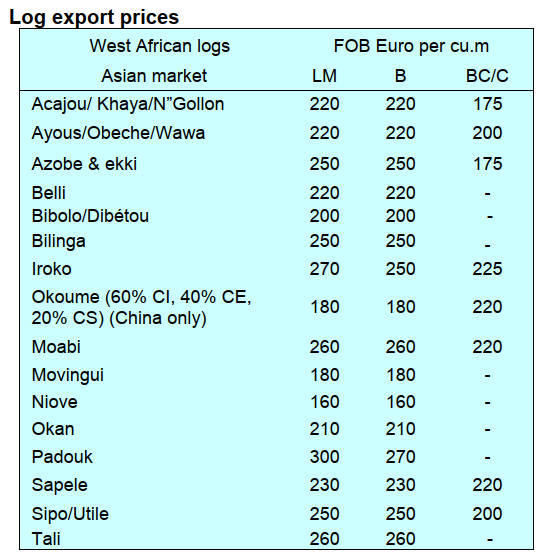
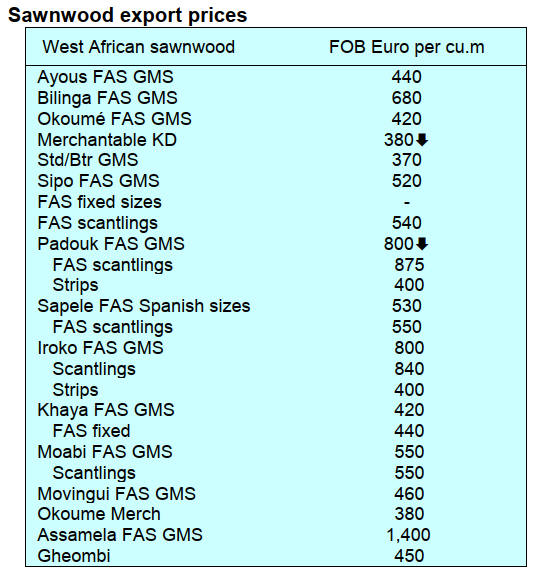
Through the eyes of industry
The latest GTI report lists the challenges identified by the private
sector in the Republic of Congo and Gabon.
See: https://www.itto-
ggsc.org/static/upload/file/20241120/1732064596197451.pdf
2.
GHANA
Tax policies can drive industrialisation - AGI
General elections will be held in Ghana on 7 December
2024 and the Association of Ghana Industries (AGI) has
signaled its desire to see the new government to use its
first budget and economic policy to introduce tax reforms
and other interventions geared towards growing industries
and generally improve the country’s business
environment.
Speaking at the Association’s 64th Annual General
Meeting (AGM, the AGI President, Dr. Humphrey Kwesi
Ayim Darke, expressed the Association’s hope to see more
innovation from the incoming government regarding
macroeconomic management and fiscal rationalisation to
consolidate gains made under the International Monetary
Fund (IMF) structured programme.
Specifically, the AGI is seeking a review of the value-
added tax (VAT), imposition of the flat tax rate and action
on exchange rate stability interventions and other business
supportive policies that would improve company
competitiveness and promote industrialisation.
See: https://www.graphic.com.gh/business/business-news/agi-
awaits-tax-reforms-next-year.html
and
https://gipc.gov.gh/wp-content/uploads/2024/11/Q2-2024-
Investment-Report-Final.pdf
and
https://agighana.org/agi-tema-branch-organizes-annual-general-
meeting-and-seminar-on-taxation/
Other speakers at the plenary session including the Chief
Executive Officer of Ghana Exports Promotion Authority
(GEPA), Commissioner in charge of the Domestic Tax
Revenue and the CEO of AGI, all spoke on key measures
that could impact industrial growth.
Wood product exports in first three quarters of 2024
According to data from the Timber Industry Development
Division (TIDD) of the Forestry Commission (FC)
revenue from wood product exports the first three quarters
of 2024 was US$93.03 million from a total export volume
of 208,108 cu.m.
The highest wood product export volume of 25,561 cu.m
was recorded in September and the lowest was in February
at 19,841cu.m.
The period also witnessed an increasing quarterly wood
export volume from 64,160 cu.m in the first quarter to
68,966 cu.m in the second quarter then to 74,976 cu.m in
the third quarter.
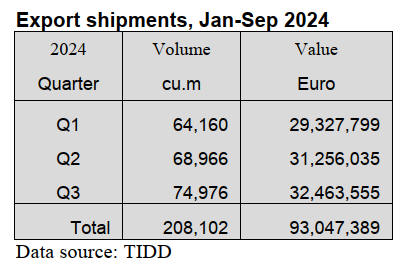
Major export markets
Countries in Asia were the major importers accounting for
between 63-65% of total export volumes for 2023
(226,000 cu.m) and 2024 (208,000 cu.m) respectively. In
terms of volume Europe was Ghana’s second largest
export market (-1% Jan-Sep) and the Africa the third ( -
3%).
The leading wood products were air and kiln dry
awnwood, rotary veneer, billets and plywood for the
regional market. The top species included Teak, Wawa,
Essa / Celtis, Ceiba and Denya.
CITES workshop to help protect natural resources
The Forest Services Division (FSD), the Timber Industry
Development Division (TIDD) and Wildlife Division of
the Forestry Commission (FC) participated in a 3-day
training workshop on Convention on International Trade
in Endangered Species (CITES), Non-Detriment Findings
(NDF) for Ghana.
This was to build capacity for the country to develop its
own NDFs for timber harvesting to protect the country’s
natural resources. The workshop also attracted local and
international industry stakeholders.
The event was organised by the CITES Scientific
Authority of Ghana, in collaboration with the German
Federal Agency for Nature Conservation (BfN) and
TRAFFIC.
The Faculty of Renewable Natural Resources, Kwame
Nkrumah University of Science (KNUST), hosted the
workshop with funding from BfN.
The event centred on the newly revised 9-Step Guidance
on Non-Detriment Findings (NDFs) for timber species.
Participants were taken through Non-Detriment Findings
procedures designed to scientifically evaluate parameters
such as species distribution and habitats, population status
and trends, harvest practices as well as volumes and
impact of trade in target species.
Professor Samuel Kingsley Oppong, a lecturer at the
KNUST, explained that the CITES Convention makes sure
that species sent out of Ghana do not negatively impact the
country’s forest cover and the environment. Hence the
formulation of the NDFs, which guides that process and
ensure sustainability of species, helping to ensure that
timber trade benefits species, ecosystems and local
communities alike.
The NDFs is a necessary precondition for issuing a CITES
permit, for natural resources that face extinction. During a
demonstration, participants were engaged in practical
exercises where they analyzed data gaps and applied the 9-
Step Guidance to the African mahogany (Khaya) three key
species namely Khaya ivorensis, K. anthotheca, and K.
grandifoliola, which are native to West and Central Africa.
See: https://fcghana.org/fc-participates-in-3-day-workshop-on-
cites-ndfs-for-ghana/
Ministry launches tree crop diversification project
The Ministry of Food and Agriculture has secured a
US$227 million credit from the World Bank to undertake
the ‘Ghana Tree Crop Diversification Project’ (GTCDP).
The Minister of Food and Agriculture, Bryan
Acheampong, said the project will raise the capacity of
stakeholders in the tree crop sector and improve their
competitiveness.
The GTCDP seeks to support sector-wide activities,
reforms and investments in the tree crop sector to enhance
production of cocoa, coconut, cashew and rubber. As part
of the project, commercial nursery operators will be
supported to supply quality planting materials to farmers
and government will also facilitate the acquisition of
planting materials and other agricultural inputs for 52,000
farmers.
According to the Minister, Bryan Acheampong, the
initiative has the potential to transform the agriculture
value chains by connecting downstream and upstream
actors. It will also address the risk of child labor in tree
crops through an integrated prevention, identification, and
remediation system.
The project aims to achieve significant outcomes, such as
increased yields and value addition for target tree crops,
improved climate adaptation strategies and substantial
reductions in greenhouse gas emissions.
The Chief Executive of the Tree Crops Development
Authority, William Agyapong Quaittoo said the project
will address some of the challenges hindering the growth
of the Tree Crop sector established in 2019. It will benefit
about 53,000 farmers and create around 20,000 jobs and
rolled out in eleven districts across six regions of Ghana.
See:
https://allafrica.com/stories/202411180344.html#:~:text=The%2
0%24227.5%20million%20five%2Dyear,youth%20within%20th
e%20agricultural%20sector.
and
https://www.myjoyonline.com/agric-ministry-launches-227m-
tree-crop-diversification-project/
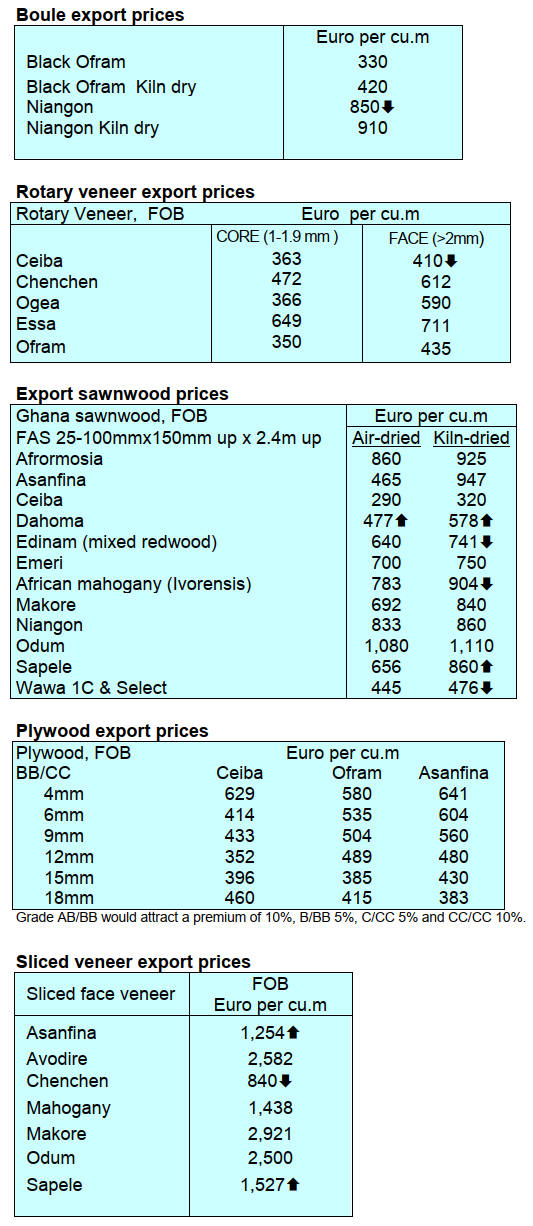
Through the eyes of industry
The latest GTI report lists the challenges identified by the private
sector in Ghana.
See: https://www.itto-
ggsc.org/static/upload/file/20241120/1732064596197451.pdf
3. MALAYSIA
Carbon offset guidelines
A Technical Working Group (TWG) for Forest Carbon
Offset Guidelines has been established by the Ministry of
Natural Resources and Environmental Sustainability
(NRES).
The TWG, working through the Malaysia Forest Fund
(MFF), is developing a national crediting system designed
to align with Malaysia’s unique environmental context
while actively supporting the country’s commitment to
maintaining over 50% forest cover. The crediting system
also fulfills the objectives of the National Policy on
Biological Diversity and Malaysia’s Nationally
Determined Contributions.
Known as the Forest Carbon Offset (FCO) the initiative
will facilitate the transfer of forest-based emissions
reduction or removals to buyers in the form of carbon
credits, enabling organisations to offset their carbon
emissions.
Following a feasibility study, a Technical Working Group
(TWG) was established, comprising experts from
government agencies, private sector, civil societies, non-
governmental organisations and academia to provide
insights and recommendations on the development of FCO
guidelines.
During the session, TWG members received an overview
of the draft guidelines prepared by MFF and were invited
to review and contribute feedback to refine the guidelines
further in preparation for the next meeting.
See: https://www.nres.gov.my/ms-
my/pustakamedia/Penerbitan/National%20Guidance%20on%20F
orest%20Carbon%20Market.pdf
and
https://mfc20.my/wp-content/uploads/2024/10/PAPER-9-
PROMOTING-SARAWAKS-FOREST-CARBON-
INITIATIVES.pdf
Environment and emission laws
Sarawak will implement two new regulations next year
aimed at enhancing environmental sustainability according
to Premier Abang Johari Tun Openg. The regulations are
the Certified External Auditors Eligibility and Registration
Regulations 2024 and the Burning and Emission
Regulations 2024.
These are designed to ensure compliance with ethical
standards and the responsibility to verify accurate reports,
thereby supporting Sarawak’s commitment to reducing
greenhouse gas emissions.
The Burning and Emission Regulations 2024 will govern
burning and gas emission activities in Sarawak by
enforcing strict controls, requiring prior approval from the
Controller of the Natural Resources and Environment
Board (NREB).
See: https://www.theborneopost.com/2024/10/23/sarawak-to-
implement-new-regulations-next-year-for-environmental-
sustainability-emissions-control-says-premier/
Restoring degraded forests
Sabah aims to convert around 400,000 ha of degraded
forest to industrial timber plantations. The Chief Minister,
Hajiji Noor, said this effort was being carried out through
the state's Action Plan on Forest Plantation Development
(2022–2036). As of October this year, he said, a total of
180,901 ha have been successfully restored and converted.
He added that rubberwood, acacia, batai, laran and red
mahogany (Eucalyptus pellita) are among the main species
in the forest plantations.
See: https://www.thestar.com.my/news/nation/2024/11/22/sabah-
to-restore-400000ha-of-degraded-forest-as-timber-plantations
Sarawak Sustainability Blueprint
The Sarawak Sustainability Blueprint, a roadmap to guide
all sectors towards harmonising economic growth and
environmental preservation was unveiled at the Sarawak
Sustainability Insights 2024 event in Kuching.
Sarawak, Abang Johari Tun Openg, said the blueprint
focuses on two critical dimensions, Green Transition and
Economic Equity with the aim of establishing a robust
framework that integrates sustainable practices.
There are 10 strategic thrusts under the Blueprint, namely
Energy Transition, Sustainable Agriculture and Food
Security, Green Mobility, Circular Economy, Sustainable
Manufacturing, Sustainable and Responsible Mining,
Protection and Enhancement of Natural Assets,
Sustainable Cities, Community Development and Eco-
Tourism.
Under the Energy Transition strategy the Premier said
Sarawak is dedicated to continue harnessing clean energy
sources to meet domestic energy demand and for power
exports.
See: https://dayakdaily.com/premier-unveils-sarawak-
sustainability-blueprint-to-guide-all-sectors-on-balancing-
economy-environmental-preservation/
Blue Carbon project to restore mangroves
The Sarawak Timber Industry Development Corporation
(STIDC) and Worldview Climate Solutions (WCS)
Malaysia have signed a Memorandum of Agreement to
launch the inaugural blue carbon project in the Tanjung
Manis area. The project aims to restore and preserve
10,000 hectares of mangrove forest.
The project aims to establish and develop a blue carbon
ecosystem, capturing and marketing carbon from restored
mangroves while supporting local biodiversity and eco-
tourism. The project is viewed not only as a significant
step in environmental conservation but also a major
opportunity to attract foreign investment that could
stimulate economic growth in Sarawak’s green energy and
eco-tourism sectors.
See: https://www.theborneopost.com/2024/11/14/stidc-wcs-sign-
moa-for-landmark-blue-project-initiative-in-tg-manis/
https://theborneopost.pressreader.com/article/281745569916284
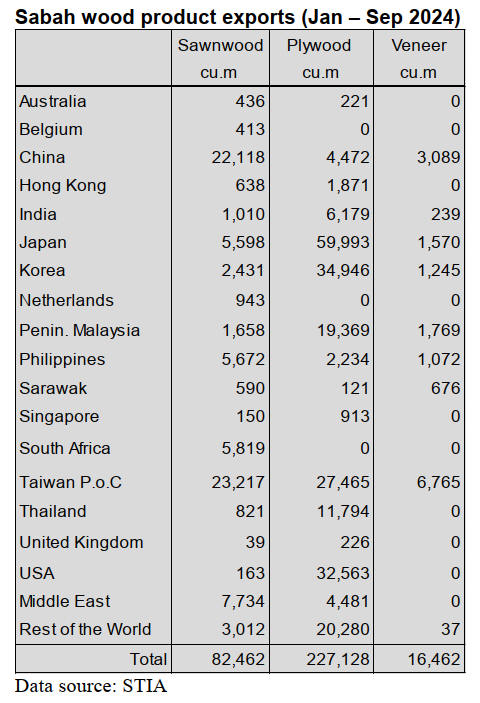
Through the eyes of industry
The latest GTI report lists the challenges identified by the private
sector in Malaysia.
See: https://www.itto-
ggsc.org/static/upload/file/20241120/1732064596197451.pdf
4.
INDONESIA
Forestry investments to create 400,000
new jobs
During a meeting with Commission IV of the Indonesian
House of Representatives the Minister of Environment and
Forestry, Raja Juli Antoni, stated that the management of
the forestry sector in 2025 will prioritise increasing
production and the downstream processing of forest
products to support regional economic development.
He said "the forestry sector is expected to see an
investment value of IDR19.9 trillion in 2025 with planned
workforce absorption of 400,000 people".
Non-tax State revenues from the forestry sector are
projected to reach IDR7.72 trillion in 2025. This estimate
is based on calculations of revenue generated from
roundwood production to meet export demand, nature
tourism visits, utilisation of forest areas and administrative
fines in the forestry sector.
The Ministry aims to achieve specific performance targets
by 2025 which include a 55% reduction in greenhouse gas
emissions from the forestry sector. Additionally, the
ministry seeks to reduce the rate of deforestation to 0.2
million hectares per year and attain a national red list
index value for species under threat.
See: https://www.msn.com/id-id/berita/other/target-investasi-
rp199-triliun-pada-2025-sektor-kehutanan-bisa-serap-400000-
pekerja/ar-AA1uusAK?ocid=BingNewsVerp
and
https://www.msn.com/id-id/ekonomi/ekonomi/pemerintah-
targetkan-investasi-di-bidang-kehutanan-capai-rp-19-9-t-pada-
2025/ar-AA1uqO8S
and
https://www.antaranews.com/video/4481113/kemenhut-
targetkan-investasi-kehutanan-capai-rp199-triliun-pada-2025
In related news, the Minister of Environment and Forestry
indicated a roadmap and strategic plan for the reforestation
of 12 million ha. of damaged forests will be prepared. This
is a follow-up to President Prabowo Subianto's directive at
the UN COP29 in Azerbaijan.
Also the Minister confirmed that he will not hesitate to
revoke the Forest Area Borrow-Use Permit (IPPKH) from
corporations that fail to meet the land rehabilitation
obligations required by the permit.
See: https://www.tempo.co/lingkungan/menteri-kehutanan-siap-
cabut-ippkh-perusahaan-yang-tidak-merehabilitasi-lahan-
1171191
and
See: https://jakartaglobe.id/news/indonesia-plans-to-reforest-12-
million-hectares-of-damaged-land
Furniture sector - FurneCraft Expo
The Ministry of Industry hosted the 2024 FurneCraft Expo
in Semarang City, Central Java aimed at enhancing the
quality of human resources in the furniture sector and
boosting export sales. The exhibition was organised by the
Furniture and Wood Processing Industry Polytechnic
(Polifurneka), a vocational education unit of the Ministry
of Industry. It featured a variety of events aimed at helping
businesses expand and widen their knowledge.
Masrokhan, the Head of the Industrial Human Resources
Development Agency of the Ministry of Industry, stated
that the exhibition themed "Bring Back Culture with
Innovative Furniture" attracted thousands of visitors from
within the country and abroad. This event opened up new
export market opportunities for small and medium-sized
enterprises allowing them to boost sales through business
matching.
See: https://www.antaranews.com/berita/4457613/kemenperin-
gelar-furnecraft-expo-dorong-kualitas-sdm-sektor-furnitur
Area allocated for Social Forestry around 8 million ha
The Ministry of Forestry and Environment has reported, as
of October 2024, the area of Social Forestry has surpassed
8 million hectares involving over 1.3 million households.
For customary forests, the achievement is recorded at
more than 250,000 hectares for 138 customary law
communities.
During a discussion at the Indonesian Pavilion at COP29
the Director General of Social Forestry and Environmental
Partnerships (PSKL) at the Ministry stated, “We are
providing access to social forestry areas spanning 8.3
million hectares which includes the recognition of
customary forests.”
Mahfudz said that social forestry has became a national
priority programme within the 2015-2019 National
Medium-Term Development Plan (RPJMN) and continued
into the 2020-2024 plan.
See: https://www.antaranews.com/berita/4479849/kemenhut-
perhutanan-sosial-capai-lebih-dari-8-juta-ha-hingga-oktober
Indonesia, Japan Agreement on carbon credit trading
The Indonesian press has reported the governments of
Indonesia and Japan have reached an agreement to initiate
Mutual Recognition Arrangement (MRA) for bilateral
carbon credit trading cooperation. This MRA is reportedly
the first bilateral cooperation model between countries
under the framework of the Paris Agreement, specifically
Article 6.2.
The Vice Minister for Global Environmental Affairs,
Ministry of Environment Japan, Yutaka Matsuzawa, stated
that through the MRA the Indonesian and Japanese
governments can develop collaboration and cooperation
towards net zero emission between the two countries.
See: https://en.tempo.co/read/1940459/indonesia-japan-reach-
agreement-on-mra-for-carbon-credit-trading-at-cop29
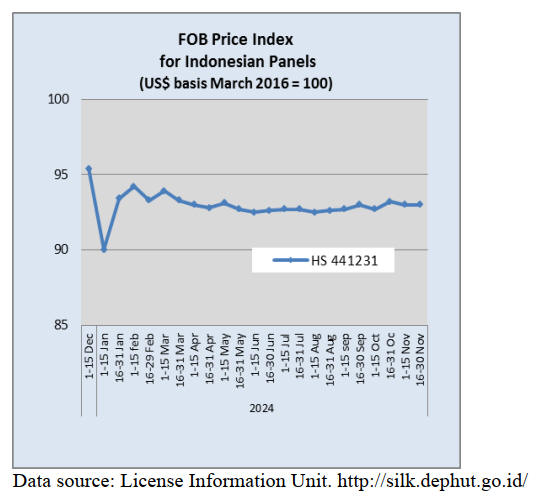
5.
MYANMAR
No timber trade data available
As the Ministry of Commerce suspended the publication
of trade data and the Myanma Timber Enterprise (MTE)
stopped uploading the results of monthly tenders reliable
statistics are hard to come by.
According to wood product manufacturers in some months
there are no bids at MTE tender sales particularly for teak
logs. Manufacturers also have to contend with inconsistent
power supplies which have forced them to rely on
generators which has pushed up production costs. The
situation for workers in the sector is dire. The cost of
living continues to climb as the effect of sanctions bite but
manufacturers are not in a position to raise wages instead
turning to a variety of in-kind support for workers.
Yacht maker fined for importing Myanmar teak
UK based Yachting Monthly magazine has reported a
luxury yacht manufacturer based in the UK has been fined
for importing teak from Myanmar, marking the first
prosecution under the UK Timber Regulation (UKTR).
See: https://www.yachtingmonthly.com/news/sunseeker-handed-
240k-fine-for-using-illegal-blood-teak-from-myanmar-on-
vessels-99901
ILO moves on possible sanctions
The International Labor Organization (ILO) is considering
taking action against the authorities in Myanmar for rights
violations.
It has been reported the ILO Governing Body will discuss
a draft resolution on measures that will be taken. This
decision was welcomed by labour advocates who have
called for international action. Maung Maung, president of
the Confederation of Trade Unions Myanmar, which has
some 65,000 members, welcomed the ILO decision.
See: https://www.ilo.org/sites/default/files/2024-10/GB352-INS-
11-%5BNORMES-240911-003%5D-Web-EN.pdf
Formal banking system in Rakhine State virtually
collapsed
The Myanmar newspaper ‘Irrawaddy’ has reported the
banking system in Rakhine State has virtually collapsed.
Banks in Sittwe, Maungdaw, Thandwe and Minbya have
ceased operations.
In mid-November the last remaining private banks shut
down in Kyaukphyu, including KBZ, CB, AGD,
Ayeyarwady, Yoma and Global Treasure Banks says the
newspaper.
With the closure of banks, residents now have to pay
higher fees to withdraw and transfer money through
mobile banking services.
See: https://www.irrawaddy.com/news/burma/rakhines-banking-
system-collapses-as-myanmar-state-teeters-on-precipice.html
6.
INDIA
Growth in pallet market
Expanding trade increases demand for pallets and wood is
the main raw material for pallet manufacturing followed
by plastic. The Indian market for wooden pallets has seen
significant growth over the years and will continue to
grow as trade volumes rise. Wooden pallets have
maintained market share as they can be reused multiple
times, aligns well with the rising awareness of sustainable
business practices and can be recycled.
The Economic Times of India points out in a recent article
that manufacturers in India have moved to ensuring
manufacturing processes use responsibly sourced raw
material. The major producers have adopted up-to-date
technologies designed to reduce waste and minimise
energy consumption.
See: https://economictimes.indiatimes.com/small-biz/sme-
sector/there-is-a-growing-market-for-recycled-and-upcycled-
pallets-jay-wood-industrys-
shah/articleshow/113756472.cms?from=mdr
Expanded agricultral output and government spending
to lift growth
A forecast from Morgan Stanley Research in its ‘2025
India Economics Outlook’ has projected India’s GDP
growth for the current fiscal year at 6.7% from 7% in an
earlier forecast. This change is mainly due to slower
growth in July-September 2024 quarter. The report
suggests GDP is likely to have rebounded to around 6.7-
6.8% in second half driven by a rise in agricultural
production and government spending.
High frequency data for July-September 2024 were weak
as indicated by revenue from the Goods and Services Tax
dipping to a 40-month low in September. Core
manufacturing sector output declined in August (after 41
months of expansion), the manufacturing PMI slipped to
an 8-month low in September and passenger and two-
wheeler vehicle sales were moderating.
This slowdown was driven by short term factors, says
Morgan Stanley, such as excessive rainfall in August
impacting production activity and a slowdown in
government spending. However October data showed a
rebound is likely. The high frequency growth data for
October does show signs of a pickup after slowing down
in the previous two months, helped by festive season
related sales.
According to Madhavi Bokil, Senior Vice-President at
Moody’s Ratings and author of their latest Economic
Forecast there are potential risks to inflation from
heightened geopolitical tensions and extreme weather
events and these underscore the Reserve Bank of India‘s
(RBI) cautious policy. The policy of the RBI, at present,
appears to be to keep the repo rate steady at 6.5% in
October and it is expected to retain its tight monetary
policy into next year.
See: https://www.morganstanley.com/asiaresearch/country-and-
region/india.html
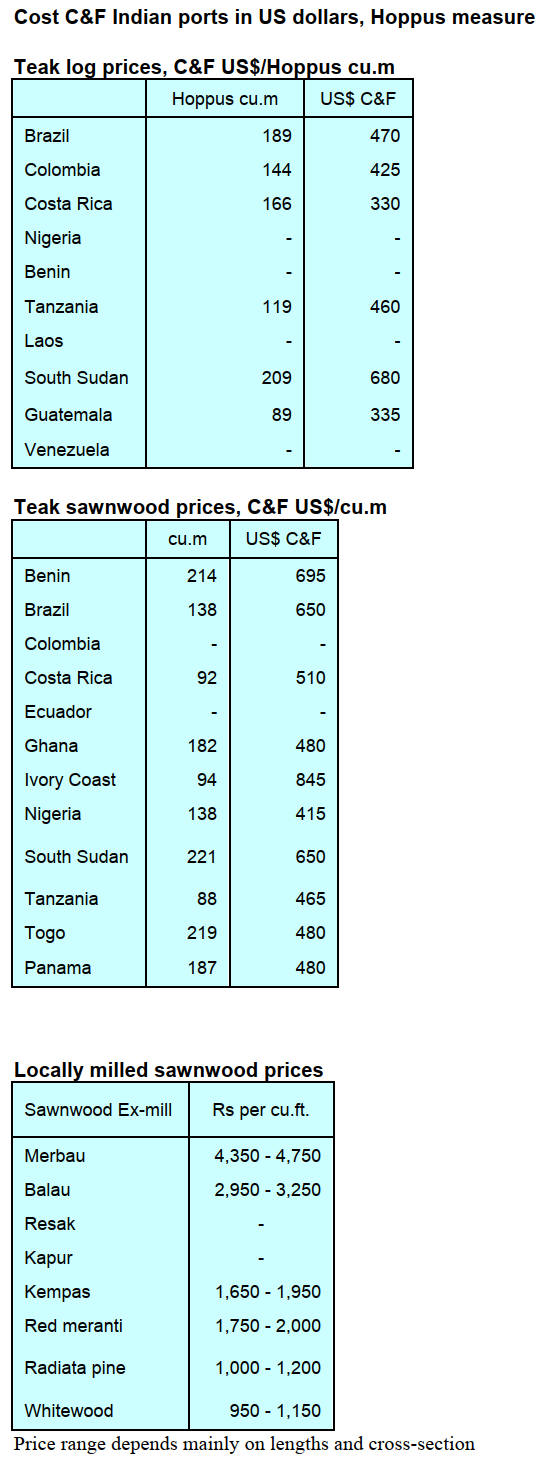 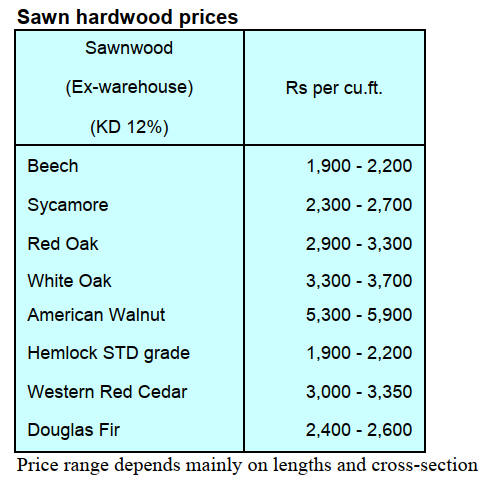
Plywood
Importers concerned on progress in proceedures for
new Ply Standard
The entry into force of the new Standards for imported
wood panel products is drawing close and the
correspondent says “there is a panic amongst Indian
importers because, so far, the Quality Control Office of the
Standards Bureau has not completed the required
international visits to checking the quality controls at
export producers necessary to complete the formalities for
issuing import licences”.
Plywood nand veneer from Nepal
While not known as a major wood product exporter the
Nepalese newspaper, Rising Nepal, has reported plywood
and veneers worth Rs3 bil. were exported to India in the
previous financial year. In Nepal logs for plywood
production are sourced from plantatiosn and farm plots of
mainly Alnus nepalensis, uttis (Alder tree) found in the
eastern hills of Nepal. During the same period, 21,994
tonnes of veneer worth Rs241 million were repoeredly
exported to India.
See: https://risingnepaldaily.com/news/46460
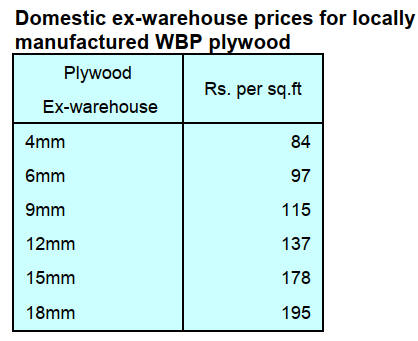
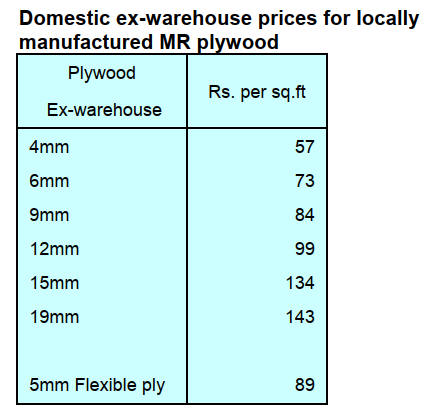
7.
VIETNAM
Wood and wood product (W&WP) trade
highlights
Statistics from Vietnam Customs show that in October
2024 the W&WP exports were valued at US$1.54
billion, up 23% compared to September 2024 and up
19% compared to October 2023. Of this, WP exports
alone reached US$1.05 billion, up 17% compared to
September 2024 and up 20% compared to October
2023.
In the first 10 months of 2024 W&WP exports earned
US$13.2 billion, up 21% over the same period in 2023
of which WP exports contributed US$9.1 billion, up
23% over the same period in 2023.
W&WP exports to the US market in October 2024
amounted to US$849.8 million, up 15% compared to
September 2024 and up 21% compared to October
2023.
Woodchip exports in October 2024 brought in about
US$240 million, up 10% compared to October 2023.
In the first 10 months of 2024,wood chip exports
earned US$2.2 billion, up 19% over the same period in
2023.
Vietnam’s W&WP imports in October stood at
US$235.9 million, up 0.6% compared to September
2024 and up 33% compared to October 2023.
In the first 10 months of 2024 W&WP imports to
Vietnam reached US$2.27 billion, up 27% over the
same period in 2023.
In September 2024, Vietnam imported 78,400 cu.m of
raw wood (logs and sawnwood) from Southeast Asia
worth US$18.56 million, down 31% in volume and
down 18% in value compared to August 2024.
Compared to the same period last year the import
volume increased by 5% and the value increased by
11%.
Vietnam’s W&WP exports to China in October 2024
amounted to US$173 million, up 20% compared to
September 2024 but down 5.5% compared to October
2023.
In the first 10 months of 2024 Vietnam’s W&WP
exports to the Chinese market totalled at US$1.7
billion, up 21% over the same period in 2023.
Exports of living and dining-room furniture in October
2024 reached US$267.6 million, up 21% compared to
October 2023.
In the first 10 months of 2024 exports of these
commodities earned US$2.2 billion, up 22% over the
same period in 2023.
Vietnam's padouk wood imports in October 2024 were
12,400 cu.m, worth US$4.1 million, up 6% in volume
and 7% in value compared to September 2024.
Compared to October 2023 imports increased in
volume but decreased by 23% in value.
In the first 10 months of 2024 imports of this wood
variety reached 106,200 cu.m, worth US$38.9 million,
down 2% in volume and down 5% in value over the
same period in 2023.
The imports of raw wood from Africa in September
2024 reached 56,460 cu.m, with a value of US$21.18
million, down 28% in volume and down 20% in value
compared to August 2024.
In the first 9 months of 2024 imports of raw wood from
Africa amounted to 522,340 cu.m, with a value of
US$193 million, down 6% in volume and down 12% in
value over the same period in 2023.
Imports of padouk
Vietnam's imports of padouk wood from all African
sources in the first 9 months of 2024 reached 77,500
cu.m, worth US$23.3 million, down 4% in volume and
down 4% in value over the same period in 2023.
The average CIF price for padouk in the first 9 months
of 2024 remained quite stable compared to the same
period in 2023 standing at US$370.8/cu.m. Prices for
African increased slightly.
Imports of padouk wood from the largest African
source accounted for 82% of the total import volume in
the first 9 months of 2024, reaching 77,500 cu.m worth
US$23.3 million, down 4% in volume and down 4% in
value over the same period in 2023.
Imports from Angola decreased by 81%; Cameroon
decreased by 31% and imports from Equatorial Guinea
fell 95% compared to the same period in 2023.
Similarly, imports from Laos decreased by 15% in
volume and decreased by 20% in value over the same
period in 2023 reaching 6,800 cu.m, worth US$6.9
million.
In addition, imports of padouk from Hong Kong
decreased by 25% in volume and decreased by 21% in
value over the same period in 2023, reaching 1,940
cu.m worth US$537,000.
In contrast, imports of padouk wood from Thailand
increased by 54% in volume and 106% in value over
the same period in 2023 reaching 5,400cu.m
Imports from Africa set to rise
Most of the wood imported from African sources is for
the production of wood products targeted at the
domestic market. In general, the demand for furniture
and interior products is rising each year so imports of
raw material from Africa will increase,
Imports from Cameroon, the largest supplier, fell
sharply by 44% in volume, equivalent to a decline of
20,120 cu.m. Imports from South Africa decreased by
14% in volume and 13% in value, Nigeria decreased by
9% in volume, Ghana decreased by 23% in volume and
15% in value. In contrast, imports from the DR Congo
increased by 14% in volume and 28% in value
compared to August 2023, Imports from Gabon
increased by 66% in volume and 44% in value.
In the first 9 months of 2024 wood imports from Africa
decreased year-on-year mainly due to a sharp decline in
imports from the 2 main suppliers, Cameroon and
Angola. Specifically, wood imports from Cameroon
decreased by 13% in volume, equivalent to 43,000
cu.m
Imports from Angola decreased sharply by 75% in
volume, equivalent to a decrease of 32,500 cu.m. In
contrast imports from selected African suppliers increased
sharply, such Nigeria by 73%, Democratic Republic of
Congo by 23% and Ghana by 37%.
Vietnam’s imports of raw wood from Southeast Asia
According to statistics from Vietnam’s Office of
Customs, in September 2024 Vietnam imported 78,400
cu.m of raw wood from Southeast Asia worth
US$18.56 million, down 31% in volume and down
18% in value compared to August 2024.
But compared to the same period last year, imports
increased by 5% in volume and 11% in value. This
growth shows that the demand for wood imports from
this region has remained, although there have been
fluctuations in volume and value.
It is forecast that in the coming months imports of raw
wood from Southeast Asia will continue to increase
due to the demand for production and consumption of
household wood furniture in the domestic and
international markets. Sawnwood will continue to be
the main import product.
Amongst Southeast Asian countries Thailand remains
the top wood material supplier for Vietnam with the
supply of 4,250 cu.m worth US$8.47 million, down
37% in volume and down 30% in value compared to
the previous month.
However, over the first 9 months of 2024 imports from
Thailand reached 474,560 cu.m, with a value of
US$87.18 million, up 31% in volume and 27% in value
over the same period in 2023.
The main commodities imported from Thailand were
chipboard and sawnwood. A large volume was shipped
to Vietnam.Laos ranks second as a source of imports
and in September 2024 imports were 15.450 cu.m,
worth US$6.15 million, up 6% in volume and 2.5% in
value compared to the previous month and up by 34%
in volume and 226% in value over the same period in
2023.
In the first 9 months of 2024 imports of raw wood from
Laos reached 160,560 cu.m with a value of US$70.69
million, up 4.5% in volume but down 2% in value over
the same period last year. Sawnwood was the main
commodity imported from Laos.
In the first 9 months of 2024 imports of raw wood from
Malaysia reached 64,110 cu.m, at a value of US$16.43
million, up 13% in volume and 0.5% in value over the
same period in 2023. Malaysia is an important supplier
of particleboard and sawnwood for Vietnam.
\Major W&WPs imported from Southeast Asia
Wood materials imported from Southeast Asea to
Vietnam are diversified with sawn wood, log,
particleboard, fiberboard etc. Of these, particlepboard
and sawnwood are the two main commodities
imported.
In the first 9 months of 2024, sawnwood imports from
Southeast Asia totalled 219,680 cu.m, with a value of
US$90.56 million, down 4% in value over the same
period in 2023. Sawn rubberwood topped imports
followed by acacia, lagerstromia (Queen Crepe Myrtle)
and sindora (Sepetir).
In the first 9 months of 2024 log imports from
Southeast Asia reached 24,010 cu.m worth US$6.57
million, down 14% in volume and down 0.1% in value
over the same period in 2023. Logs of teak, acacia,
rubberwood and iron-wood dominated the imports.
Particleboard imports from Southeast Asia reached
35,790 cu.m, at a value of US$4.66 million in
September 2024, down 48% in volume and down 48%
in value compared to August 2024.
In the first 9 months of 2024 the volume of imported
particleboard reached 307,530 cu.m, with a value of
US$40.58 million, up 50% in volume and 51% in value
over the same period in 2023. This product is imported
mainly from Thailand and Malaysia with Thailand
being the largest supplier.
8. BRAZIL
Bioeconomy and biodiversity mapping in the
Amazon
An expert panel on “Amazon Biodiversity and
Archaeology Mapping: Promoting Territory Protection
and Bioeconomy” organised bythe Alana Foundation,
Mapbiomas and the Ministry of Development, Industry
and Foreign Trade (MDIC) was held during the G20
meeting.
The panel discussed ways to promote a sustainable
bioeconomy in the Amazon, balancing territorial
protection, biodiversity conservation and local community
engagement. Experts discussed combining advanced
technologies and traditional knowledge to accelerate
biodiversity mapping, a crucial step for national
sustainability.
The Amazon is home to around 1.5 million species that
have already been mapped but it is estimated to be home
to million of species of fauna and flora yet to be
discovered. Initiatives such as the XPRIZE Rainforest,
funded by the Alana Foundation, encourage the
development of technological solutions aligned with
traditional knowledge to map tropical forest biodiversity.
In September 2024 the G20 approved a declaration
establishing principles for developing the bioeconomy in
the world. For the first time, this topic was addressed in a
multilateral agreement, integrating the bioeconomy into
macroeconomic decision-making and discussions among
nations. This milestone is seen as a strategic step forward
in integrating sustainability and global development.
See: https://www.g20.org/pt-br/noticias/painel-discute-
bioeconomia-e-mapeamento-da-biodiversidade-para-a-protecao-
da-amazonia-a-maior-floresta-tropical-do-mundo
Brazil advances in new forest fund
During the 29th UN Climate Conference held in
Azerbaijan, representatives from countries with large areas
of tropical forests met during the event to advance a joint
conservation agenda which they plan to present to the
world by 2025.
The strengthening of a new funding mechanism for
conservation is important for Brazil which sees the
initiative as a key strategy for fulfilling its pledge to
eliminate deforestation by 2030.Currently, a coalition
‘United for Our Forests’ includes 18 countries out of 53
nations with significant tropical forest areas.
Among the main members are Brazil and other Amazon
countries, Mexico, Guatemala along with the Democratic
Republic of Congo which is the second largest forested
country in the world and Indonesia, the third largest
forested country in the world.
The new financial mechanism, called the ‘Tropical Forests
Forever Fund’ made significant progress in 2024 gaining
support from countries, including Germany, the United
Arab Emirates, Malaysia, Colombia and Indonesia. The
fund aims to raise US$125 billion from wealthy countries
and financial institutions, offering payments per preserved
hectare, penalising deforestation and providing additional
benefits for biodiversity protection and traditional
communities.
For Brazil, strengthening this new financing fund for
preservation is fundamental as it sees the initiative as a
practical alternative to achieve its zero-deforestation target
by 2030. However, the details of the TFFF will only be
presented at COP30, scheduled to take place in Belém, in
the State of Pará, Brazil.
See: https://oeco.org.br/reportagens/mirando-o-desmatamento-
zero-brasil-avanca-em-novo-fundo-de-preservacao/
Export update
In October 2024 the Brazilian exports of wood-based
products (except pulp and paper) increased 20% in value
compared to October 2023, from US$219.9 million to US$
263.6 million.
Pine sawnwood exports increased 75% in value between
October 2023 (US$8.6 million) and October 2024
(US$50.1 million). In volume, exports increased 62%
from 127,900 cu.m (October 2023) to 206,500 cu.m
(October 2024).
Tropical sawnwood exports increased 5% in volume, from
20,600 cu.m in October 2023 to 21,700 cu.m in October
2024. However the value decreased 4% from US$9.1
million to US$8.7 million, over the same period.
Pine plywood exports increased 30% in value in October
2023 (US$43.8 million) compared to October 2024
(US$57.1 million). In volume, exports increased 20% over
the same period, from 140,600 cu.m (October 2023) to
169,100 cu.m. (October 2024).
As for tropical plywood, exports decreased 8% in
value
and increased 24% in volume, from US$1.3 million and
1,700 cu.m in October 2023 to US$ 1.2 million and 2,100
cu.m in October 2024.
As for wooden furniture, the exported value increased
from US$ 46.2 million in October 2023 to US$48.2
million in October 2024, an increase of 4% in the total
exports of the product during the period.
Participation in the Global Market Conference
Recenly ABIMCI (Brazilian Association of Mechanically
Processed Timber Industry) participated in the Global
Market Conference, held in London by Timber
Development UK (TDUK).
The event attracted around 300 representatives from
various countries and highlighted topics such as trends in
the UK timber market, supply, consumption, the role of
timber in mitigating climate change, carbon sequestration
and storage, challenges in raw material supply, growth
projections, technological innovations and international
markets.
ABIMCI presented an overview of the Brazilian plywood
segment, emphasising the sustainable origin of raw
materials sourced from planted forests, particularly pinus
species and compliance with various international
certification requirements.
The Association highlighted Brazil as an important global
supplier signaling it is well-prepared to meet the needs of
the British market which imports 65% of its pine plywood
from Brazil, as well as all the other main markets, in terms
of supply and in terms of compliance with origin and
technical certifications. With declining interest rates and
inflation in the UK projections indicate growth in the UK
construction sector of 2% in 2025 and 3.5% in 2026 which
could further increase Brazilian participation in this
market.
See: https://abimci.com.br/abimci-participa-da-global-market-
conference-em-londres/
Norway support for Amazon Fund project
Norway has announced a donation of US$60 million to the
Amazon Fund, reaffirming a long-standing partnership
between Norway and Brazil on climate and rainforest
preservation. The Brazilian government has set a target of
zero deforestation in the Amazon by 2030, a critical target
for the world's largest rainforest.
The Amazon Fund, established 16 years ago, is a results-
based mechanism managing international contributions to
combat deforestation and promote sustainable
development. Since its inception, the fund has financed
114 projects, including the protection of conservations
areas, support for indigenous communities, fires
prevention and backing sustainable business activities.
See: https://www.norway.no/pt/brasil/noruega-brasil/noticias-
eventos/brasil/noruega-anuncia-doacao-de-us$-60-milhoes-ao-
fundo-amazonia/
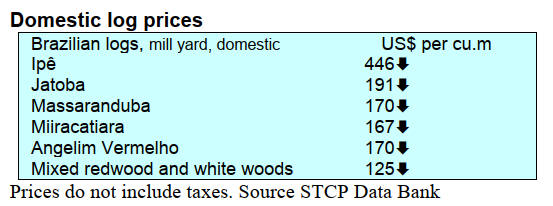 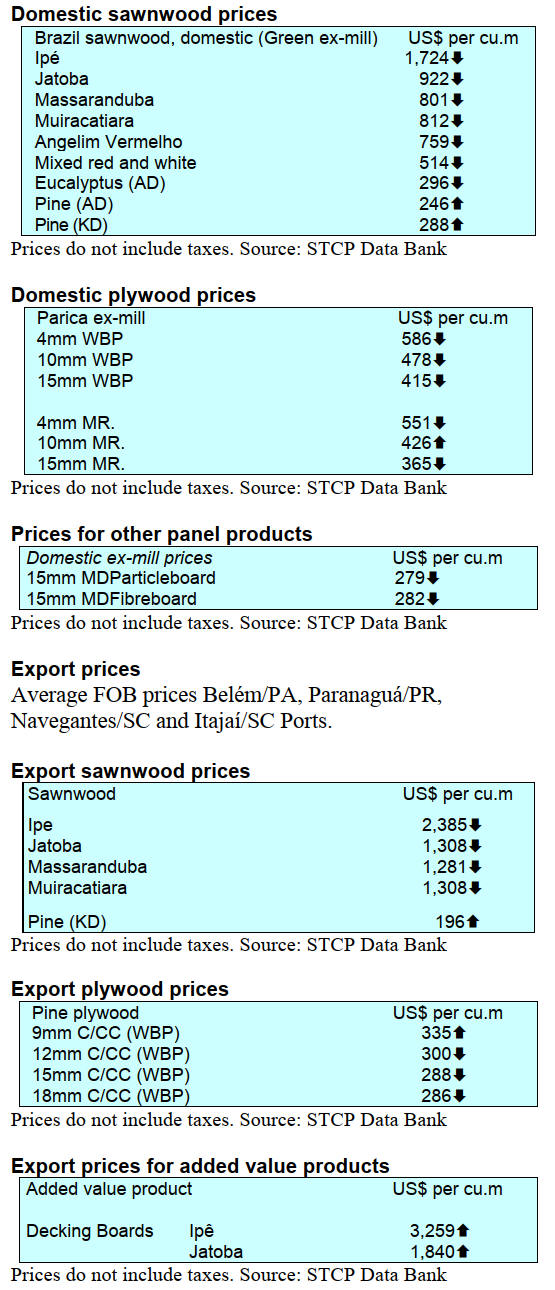
Through the eyes of industry
The latest GTI report lists the challenges identified by the private
sector in Brazil.
See: https://www.itto-
ggsc.org/static/upload/file/20241120/1732064596197451.pdf
9. PERU
First three quarter
exports
The Association of Exporters (ADEX) has reported
between January and September 2024 Peru's wood product
exports earned US$64.2 million, a drop of 16% compared
to the US$76.3 registered in the same period of 2023.
ADEX reports that in the first nine months of this year the
main export products were semi-manufactured items
which earned US$24.1 million or 37% of total export
earnings for the period followed by sawnwood (US$21.5
million, 33% share), firewood and charcoal (US$4.5
million, 7% share) then construction products, US$4.3
million and finally furniture and parts, US$3.4 million.
The main destinations were France (US$0.6 million), the
United States (US$9.9 million), China (US$8.8 million),
the Dominican Republic (US$8.3 million) and Mexico
(US$7.7 million). The top ten export destinations included
Vietnam, Denmark, Belgium, Germany and Chile.
Progress on an Andean agenda to protect forests
The creation of an Andean agenda to protect forests and
combat illegal logging in accordance with the roadmap
established in the proposed regulatory framework and
approved by the Andean Parliament, was addressed at the
Second Regional Workshop on ‘Dissemination of
Regulatory Frameworks in Environmental Matters’ which
took place in Ecuador.
The Andean parliamentarian, Juan Carlos Ramírez,
participating in the meeting on behalf of Peru held a series
of meetings with authorities from the neighboring country
that allowed for an exchange of experiences and
challenges to strengthen sustainable forest management in
the countries of the Andean Community (CAN).
The Peruvian Andean parliamentarian held meetings with
officials from the Ministry of Agriculture and Livestock of
Ecuador with whom firm steps were taken towards the
establishment of a regional agenda to confront illegal
logging and protect the Amazonian forests of the Andean
region.
See: https://www.elperuano.pe/noticia/257733-tala-ilegal-
avanzan-en-una-agenda-andina-para-proteger-los-bosques-de-la-
region
Reinforcing measures to lower risk of corruption
The National Forest and Wildlife Service (SERFOR) in its
capacity as the governing body of the National Forest and
Wildlife Management System (SINAFOR) and within the
framework of the implementation of the Integrity Model,
held a working group with the technical assistance of
representatives of the Green Corruption Program and the
Subnational GFP Programme (Swiss Economic
Cooperation) implemented by the Basel Institute on
Governance.
This was in order to establish technical cooperation
mechanisms to evaluate and prioritise corruption risks
throughout the wood value chain and propose measures
for mitigation.
As a result of the working group, SERFOR, with the
technical assistance of the Basel Institute on Governance,
presented to the Secretariat of Public Integrity (SIP) of the
Presidency of the Council of Ministers (PCM), within the
framework of the implementation of the Preventive
Capacity Index against Corruption (ICP), the
identification, evaluation and treatment sheets on the
corruption risks identified in the institution.
In this way, SERFOR took on the challenge of promoting
and reinforcing the implementation of a series of measures
to lower corruption risks at an institutional level.
New Director at SERFOR
Through Supreme Resolution No.018-2024-Midagri the
Government appointed forestry engineer, Desiderio
Erasmo Otárola Acevedo, as the new executive director of
the National Forest and Wildlife Service (SERFOR).
Otárola Acevedo is a graduate of the National Agrarian
University - La Molina and holds a Master's degree in
Integrated Management of Natural Resources with an
emphasis on management and silviculture of natural
forests from the Tropical Agricultural Research and
Higher Education Center (CATIE) in Costa Rica. He has
more than 17 years of experience in public administration.
Pilot study on extent of illegal logging in Madre de
Dios
In a joint action to address illegal logging and timber trade
in the Amazon the Forest and Wildlife Resources
Oversight Agency (OSINFOR) and the Regional Forest
and Wildlife Management of Madre de Dios (GERFOR
Madre de Dios) began a pilot study to estimate the rate and
percentage of illegal logging in 2024.
The head of OSINFOR highlighted that this study will
provide specific information to identify improvements
required in the regional work plan.
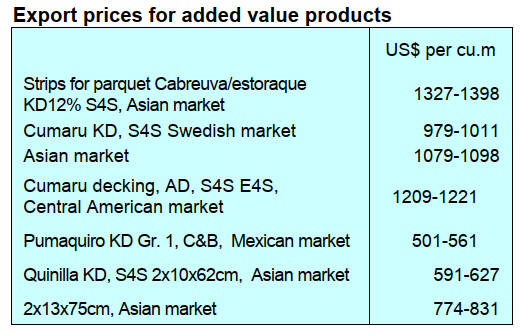

|